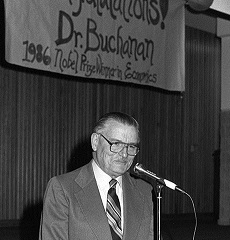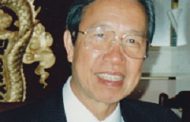
James M. Buchanan on the occasion of his Nobel win (George Mason University)
Economist and Nobel laureate James M. Buchanan has died at age 93, as first reported by his George Mason University colleague Tyler Cowen. According to his colleague Alex Tabarrok, who heads the Center for the Study of Public Choice at George Mason which Buchanan founded, he was active until the very end, producing papers and giving lectures on a regular basis.
Buchanan is most famous for breathing new life into political economy, the subfield of economics and political science that studies political institutions, and in particular how they affect the economy. In particular, Buchanan is strongly associated with public choice theory, an approach which assumes that individual actors in political contexts are out for themselves, and then uses game theory to model their choices, with the hope of gaining insight into the incentives faced by political actors.
Before Buchanan, economics was primarily about how individuals make choices in the private sphere. He was among the first to argue that it could explain their choices in the public sphere as well. Traditionally, economists have treated the government as a dictatorial “social planner” which is capable of impartially correcting failures in private markets. Buchanan’s contribution was pointing out that that social planner also responded to incentives, and that they sometimes pushed him to make markets worse off than he found them.
 James M. Buchanan (left) and his frequent co-author Gordon Tullock. (GMU)
James M. Buchanan (left) and his frequent co-author Gordon Tullock. (GMU)
The picture Buchanan and his colleague Gordon Tullock painted, first and most notably in their book “The Calculus of Consent,” is of public institutions as mechanisms for “collective action,” wherein self-interested actors make choices that add up to suboptimal policies. Politicians who are out for themselves are likely to make deals with businesses that benefit each party but which hurt other people. A city councilor who wants support from cabdrivers, for instance, could support limiting the number of taxi medallions to keep prices high, which helps the cabdrivers but hurts consumers.
The only way to eliminate such cronyism, Buchanan and Tullock argued, was to insist on unanimity among the members of a polity, but obviously no government can operate if it insists on unanimity among its citizens first. So they argued that some kind of supermajority system was probably preferable to pure majority rule, as it would allow for broadly beneficial policies while preventing those that help the majority at great cost to a minority.
But more important than their particular prescriptions was the distinction they drew between the choices to be made when drafting constitutions, and thus laying down the rules for political actors, and the choices made once the rules are set. Once the rules are clear, Buchanan and other public choice theorists argued that there was basically no room for convincing politicians. As the Royal Swedish Academy of Sciences explained in awarding Buchanan the Nobel, “Attempts to advise politicians or affect the outcome of specific issues are often futile; for any given rule system, the outcome is determined largely by prevailing political constellations.”
That approach was wildly influential. Buchanan’s contemporary Anthony Downs used similar methods to develop his “median voter theorem,” which posited that in a majoritarian democracy, policies will converge to fit the preferences of the voter in the absolute middle of the ideological spectrum, while Mancur Olson wrote “The Logic of Collective Action,” which helped introduce the idea of a “collective action problem” to economics and political science, partially in response to Buchanan’s theories. Both of those authors’ conclusions, and in particular Olson’s finding that a number of rational individuals can collectively come to irrational decisions, have become almost universally accepted in the social sciences.
Donald Green and Ian Shapiro’s “Pathologies of Rational Choice Theory“ is perhaps the best critique of Buchanan’s approach to political economy. (Yale University Press)
The view is not without its detractors. Public choice theory has been criticized for lacking empirical support, and for assuming that agents are more self-interested and rational than they are in practice. Fellow Nobelist Amartya Sen’s objections in particular were trenchant and hilarious:
“Where is the railway station?” he asks me. “There,” I say, pointing at the post office, “and would you please post this letter for me on the way?” “Yes,” he says, determined to open the envelope and check whether it contains something valuable.
That, Sen argues, is what people would act like if rational choice theories like Buchanan’s were true. But obviously no one does that. When asked where the railway station is, we point to the railway station. Buchanan and his allies would respond that while the theory obviously cannot be used to explain all cases, it does explain some big phenomena, and that dismissing it on the basis of small examples like this doesn’t do it justice.
Whether you buy his theories or not, Buchanan did enormous good in puncturing the shockingly common idea that political actors can be thought of as divorced from, well, politics. When evaluating a policy, he stressed, we shouldn’t just evaluate the policy itself. We should evaluate what incentives are necessary to get politicians to adopt it.
Dylan Matthews











































